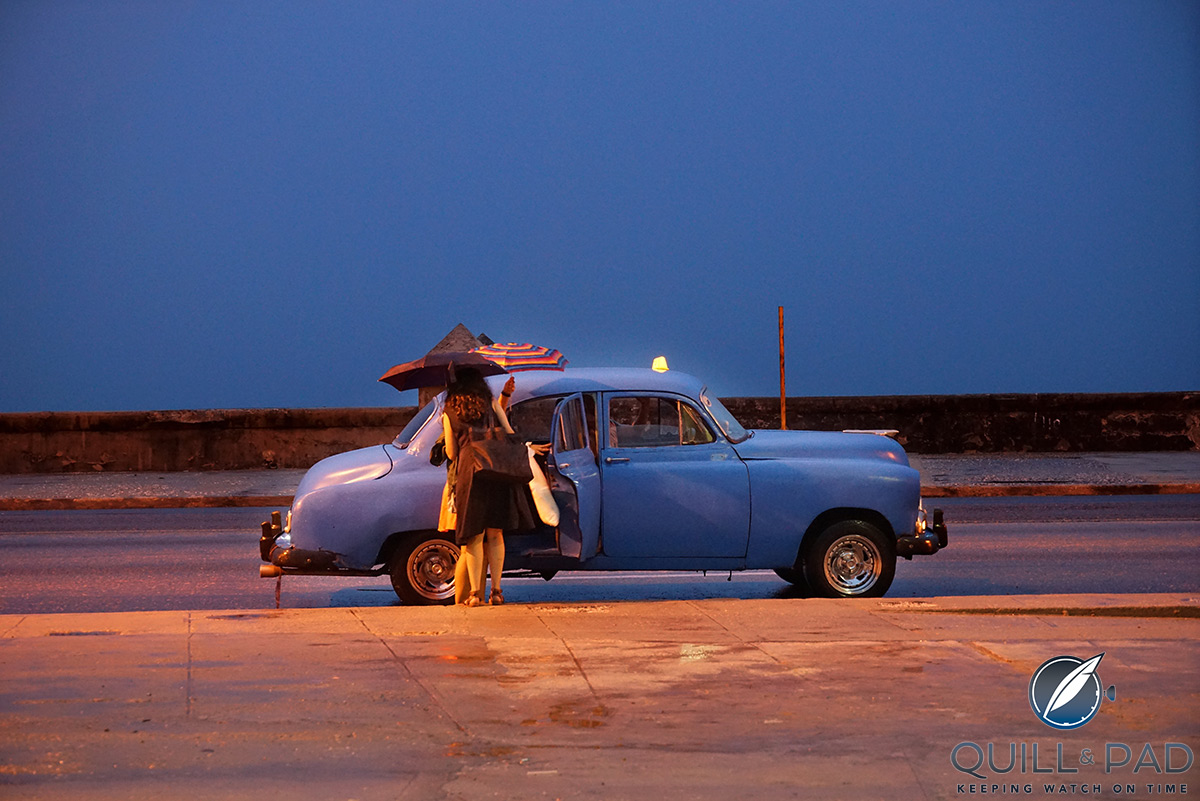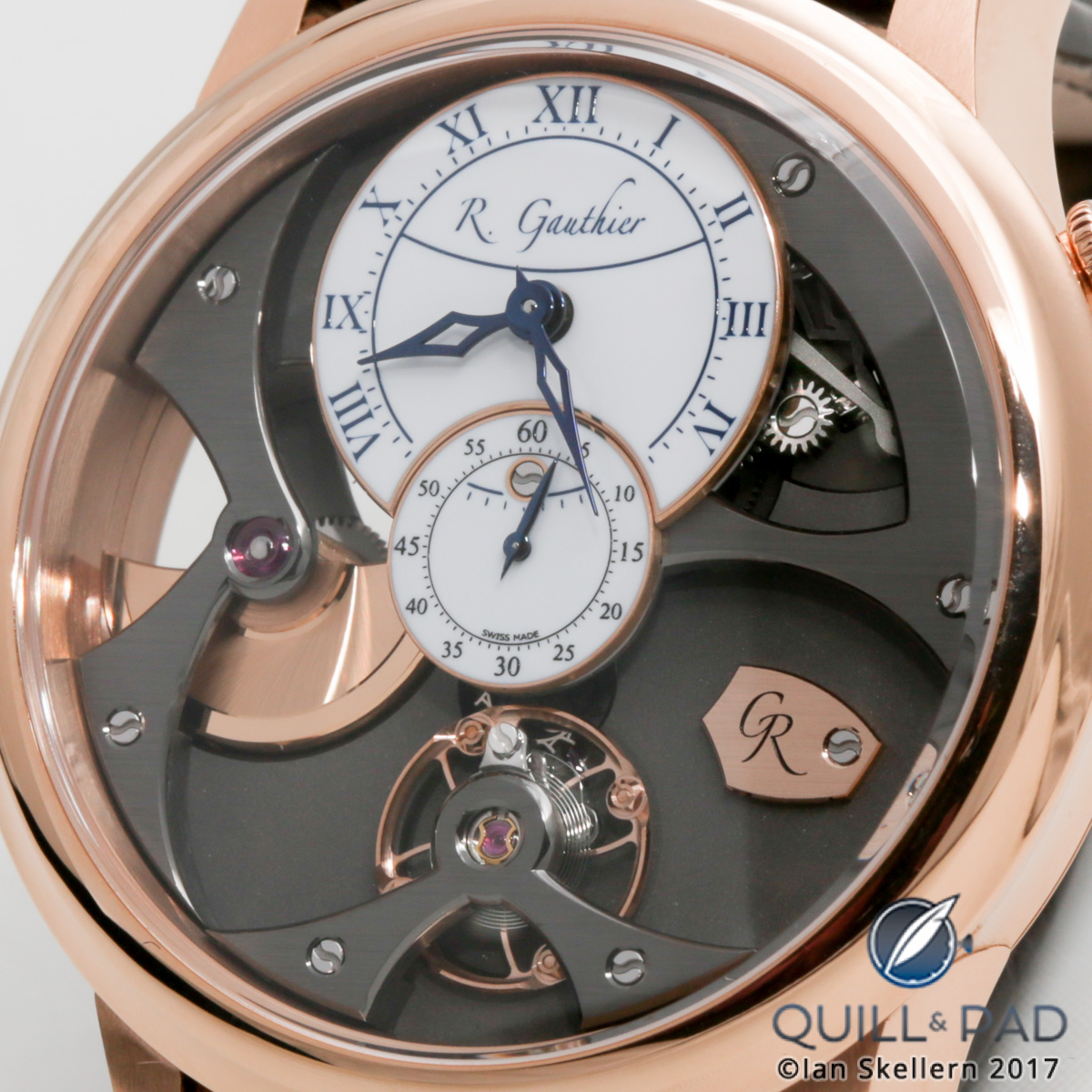The TAG Heuer Carrera Calibre 36 Flyback is a study of both the past and the present, in that it combines three innovative ideas from the 1960s into a modern, contemporary chronograph. The first of these ’60s icons is of course the Carrera itself, with the case design of the current range staying true to the very first Carrera of 1963. Then of course there is the movement, the famous El Primero, introduced in 1969 and still made today by TAG Heuer’s sister company Zenith. And lastly we have a design layout that replicates Heuer’s Stopwatches of the 1960s, which shifted the focus of the dial away from minutes and towards seconds by moving the seconds counter to the most prominent part of the dial. Yet the result is far from retro, with the Carrera Calibre 36 looking modern and sporty, especially the Titanium-cased Racing model. 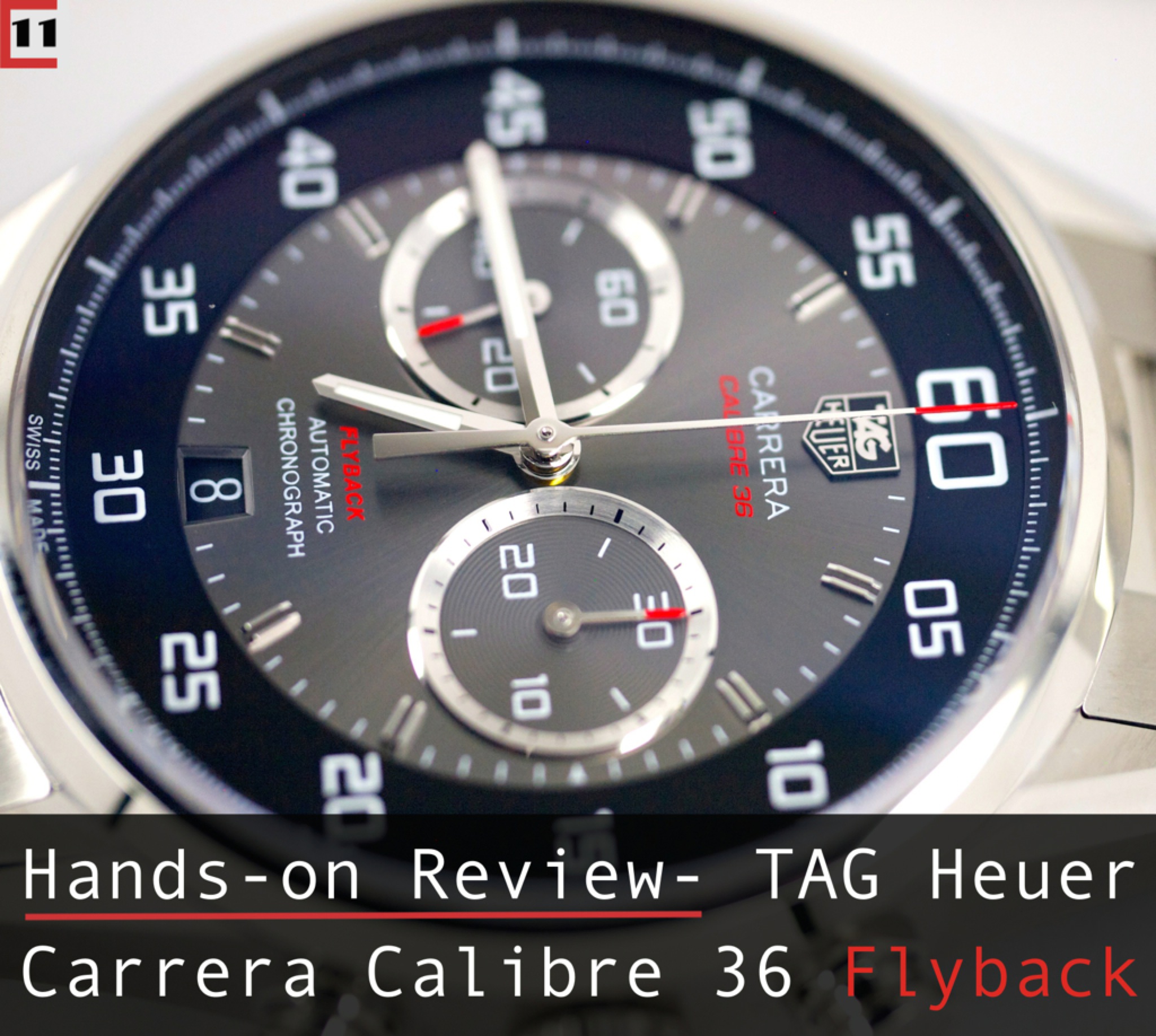 Despite TAG Heuer first offering the El Primero (called the Calibre 36 by TAG Heuer) in 2002, it has taken more than 10 years for TAG Heuer to release the high-end movement in its top-selling model- the Carrera.
Despite TAG Heuer first offering the El Primero (called the Calibre 36 by TAG Heuer) in 2002, it has taken more than 10 years for TAG Heuer to release the high-end movement in its top-selling model- the Carrera.
Flyback?
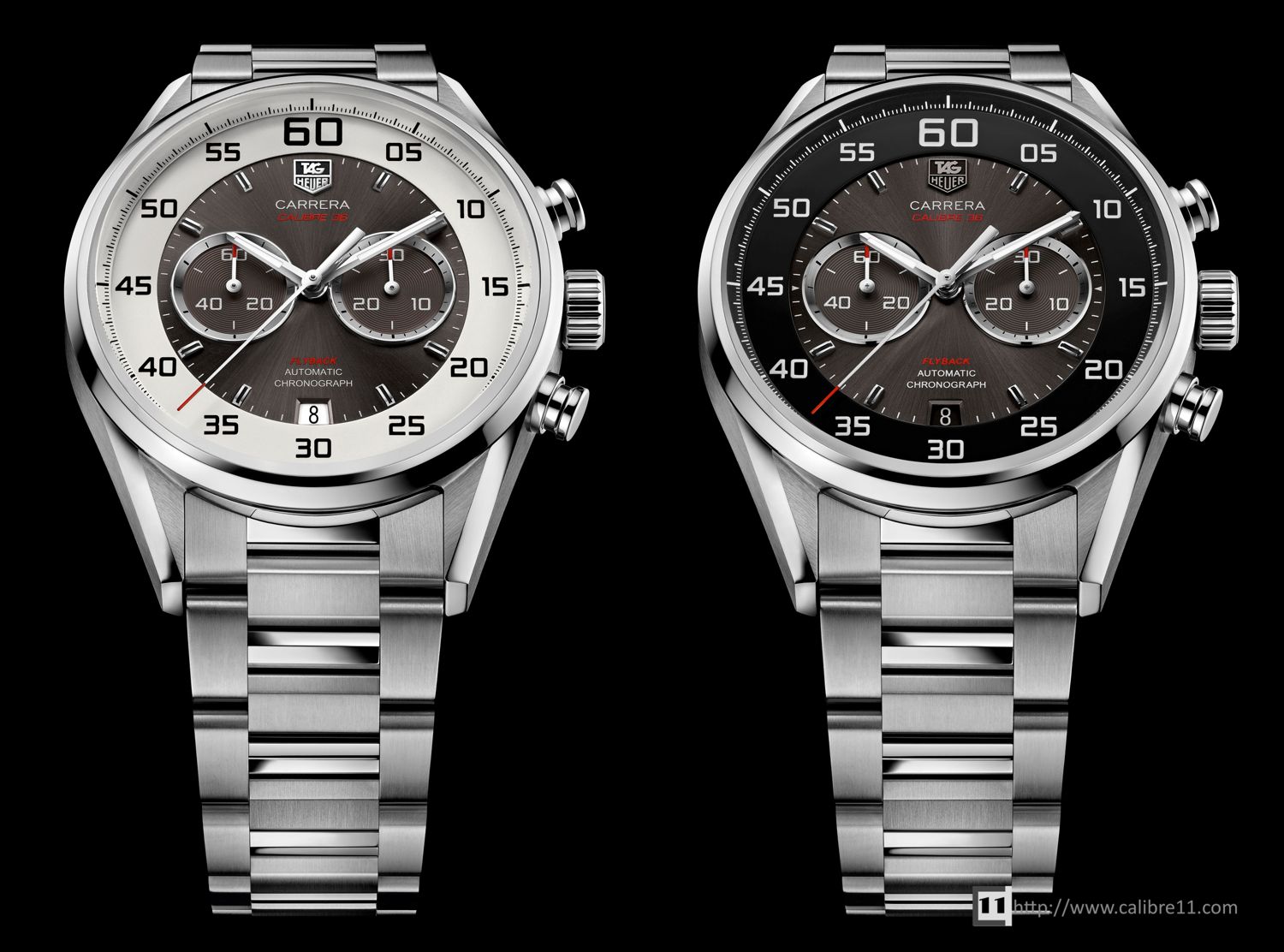 While the high-end Calibre 36 is nothing new to TAG Heuer fans, the addition of a Flyback complication is. A normal chronograph is started and stopped with the top chronograph pusher and then re-set to zero with the bottom pusher. You have to stop the chronograph before you re-set to zero. The Flyback is different, in that you can press the bottom pusher while the chronograph is active This resets the hand back to zero and continues timing, something essential for military pilots for whom the complication was originally developed. This is not the only flyback in the historical Heuer/ TAG Heuer Catalogue, with the Heuer Bundeswehr offering a flyback complication.
While the high-end Calibre 36 is nothing new to TAG Heuer fans, the addition of a Flyback complication is. A normal chronograph is started and stopped with the top chronograph pusher and then re-set to zero with the bottom pusher. You have to stop the chronograph before you re-set to zero. The Flyback is different, in that you can press the bottom pusher while the chronograph is active This resets the hand back to zero and continues timing, something essential for military pilots for whom the complication was originally developed. This is not the only flyback in the historical Heuer/ TAG Heuer Catalogue, with the Heuer Bundeswehr offering a flyback complication.
Design
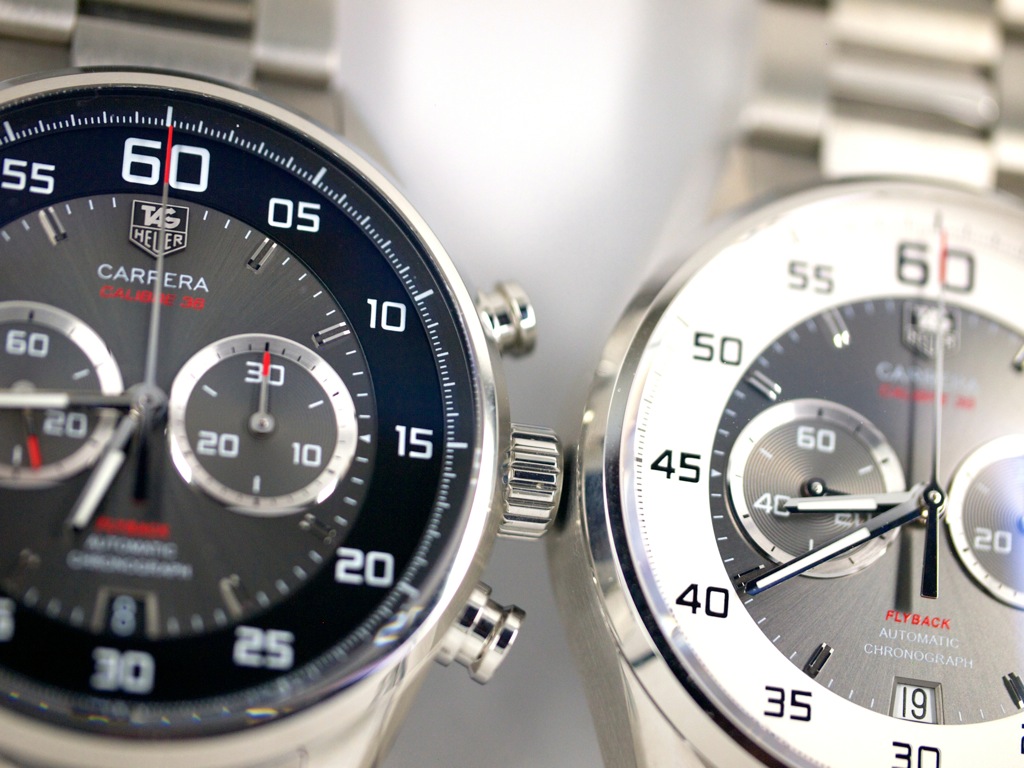 The Carrera Calibre 36 is a development of the Heuer Carrera Mikrograph, launched by TAG Heuer in 2011. The Mikrograph is famous for offering a 1/ 100th second chronograph and solving the challenge that evaded TAG Heuer’s previous efforts at this precision of timing (the Calibre 360): how do you make it easy to read the elapsed time when the fractions of a second are so small?
The Carrera Calibre 36 is a development of the Heuer Carrera Mikrograph, launched by TAG Heuer in 2011. The Mikrograph is famous for offering a 1/ 100th second chronograph and solving the challenge that evaded TAG Heuer’s previous efforts at this precision of timing (the Calibre 360): how do you make it easy to read the elapsed time when the fractions of a second are so small?
The answer was to revert to the classic stopwatch design of the 1960s that focused the dial on seconds rather than minutes/ hours, which is why the scale of the markers go from 1 to 100, and not 1 to 12 in the case of a traditional watch. 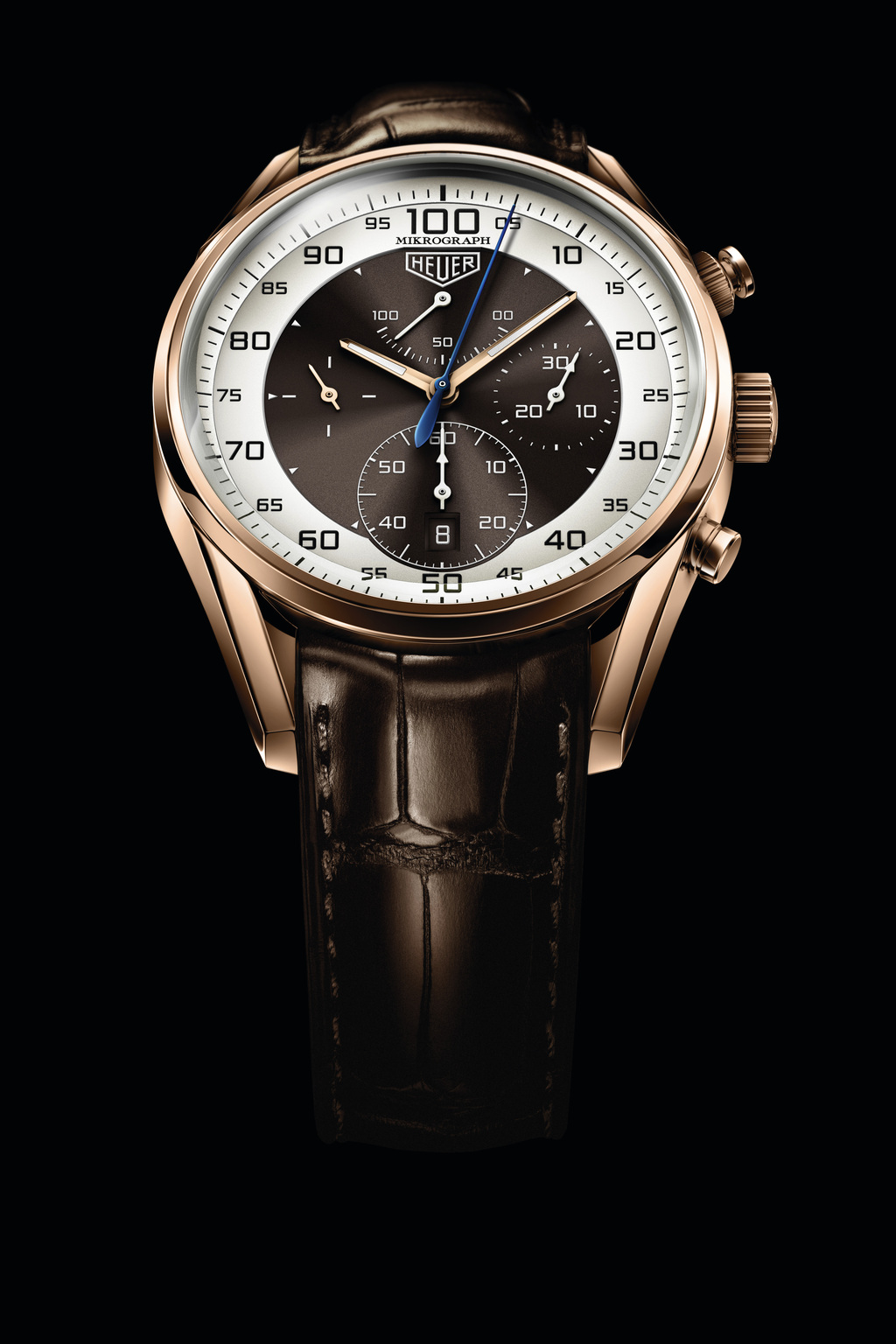 This principle works superbly, but necessitates a two-part dial, with the inner part showing the normal hour-markers (the small triangles on the dial above). The use of contrasting colours further helps this distinction So think of the Carrera Calibre 36 as being a production watch inspired by the haute horlogerie Carrera Mikrograph and you have a good starting point for what to expect.
This principle works superbly, but necessitates a two-part dial, with the inner part showing the normal hour-markers (the small triangles on the dial above). The use of contrasting colours further helps this distinction So think of the Carrera Calibre 36 as being a production watch inspired by the haute horlogerie Carrera Mikrograph and you have a good starting point for what to expect.
Case
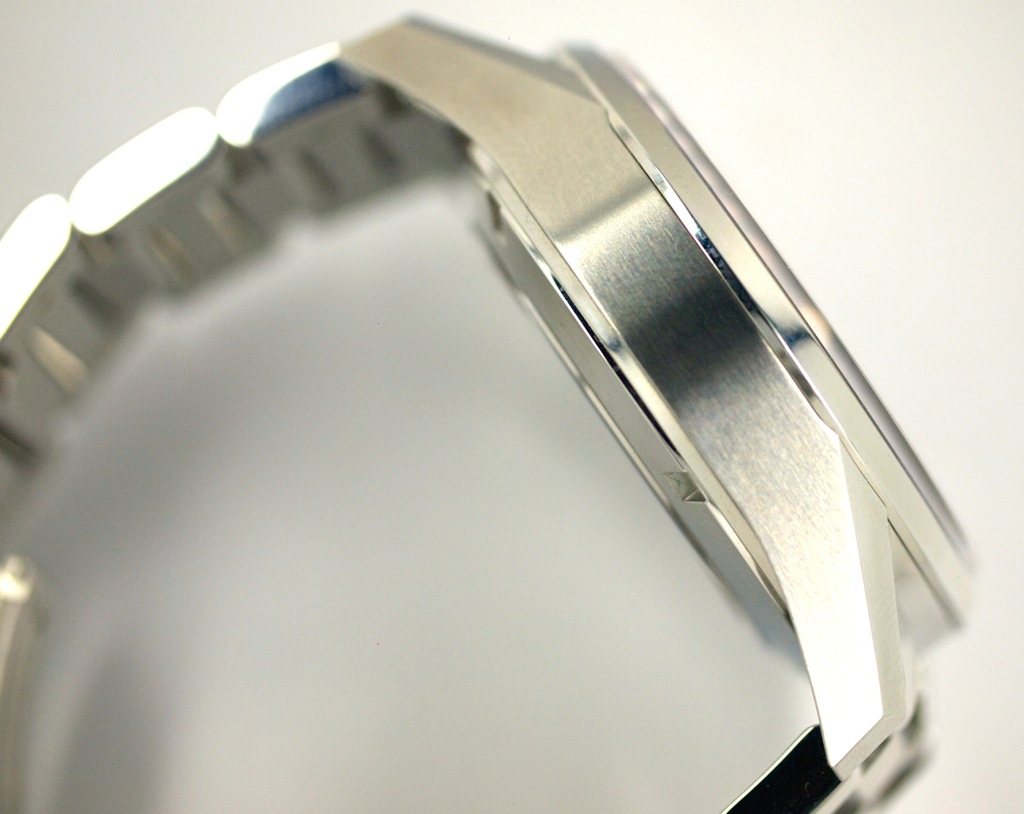 The case is one of the larger sizes offered for a Carrera at 43mm, and with a thickness of 14.93mm, which to put in context is slightly slimmer than the Carrera 1887, which comes in at 15.78mm. There are two materials offered for the case, Stainless Steel and Titanium-carbide-coated Titanium. The steel models have a combination of brushed and polished finishes, which off-set each-other nicely, for example, the polished underside of the bezel (above).
The case is one of the larger sizes offered for a Carrera at 43mm, and with a thickness of 14.93mm, which to put in context is slightly slimmer than the Carrera 1887, which comes in at 15.78mm. There are two materials offered for the case, Stainless Steel and Titanium-carbide-coated Titanium. The steel models have a combination of brushed and polished finishes, which off-set each-other nicely, for example, the polished underside of the bezel (above). 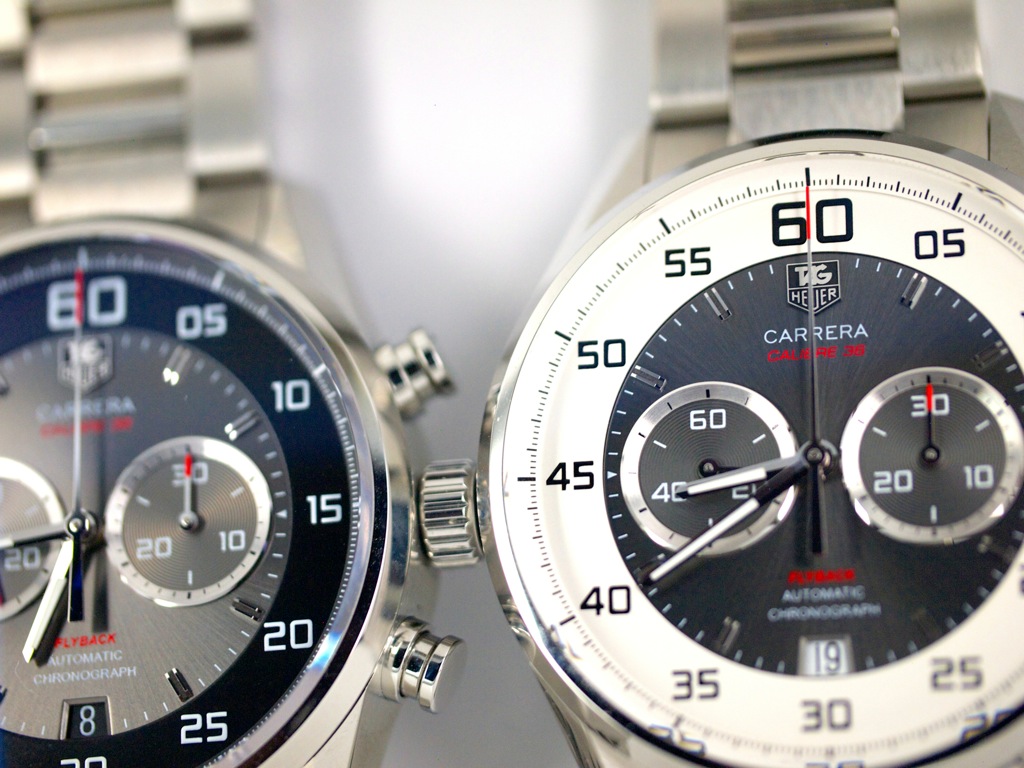 The pushers and crown on the steel models are based on the Carrera 1887 design, while the Titanium model (below) gains a different look…think you’ve seen this before?
The pushers and crown on the steel models are based on the Carrera 1887 design, while the Titanium model (below) gains a different look…think you’ve seen this before? 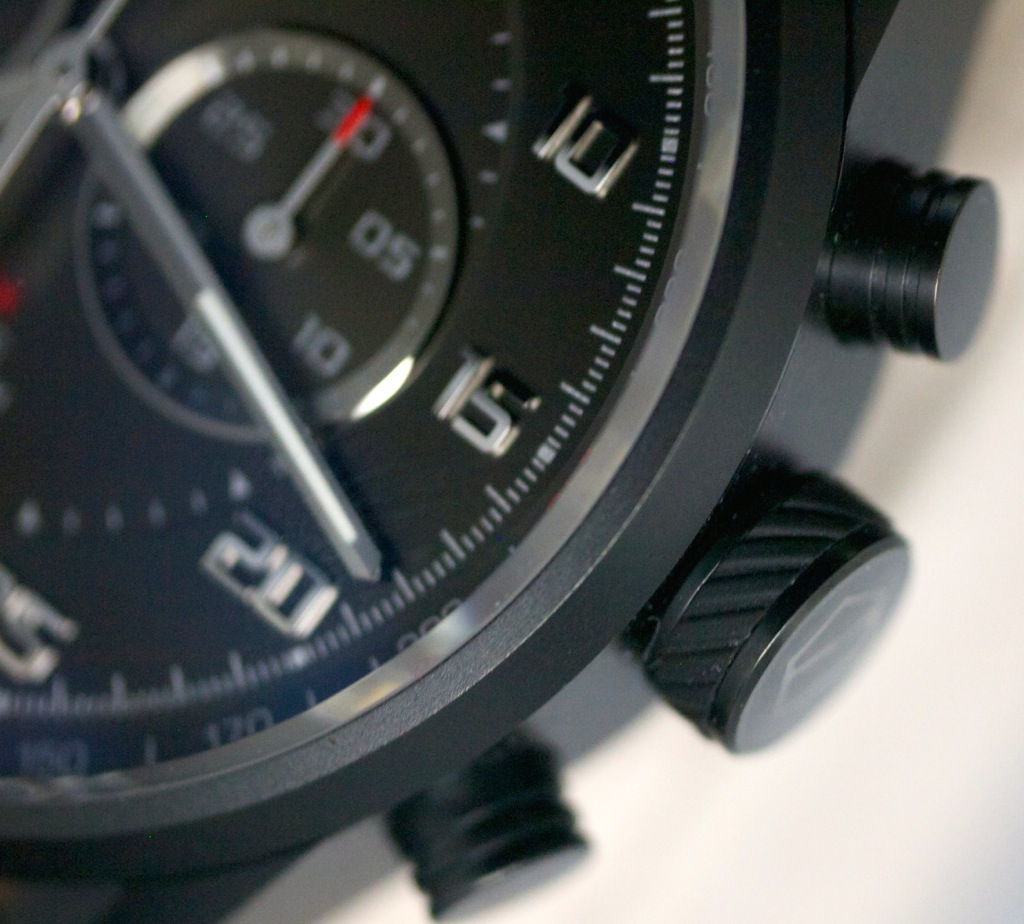 You have- the Carrera McLaren MP4-12C (below)
You have- the Carrera McLaren MP4-12C (below) 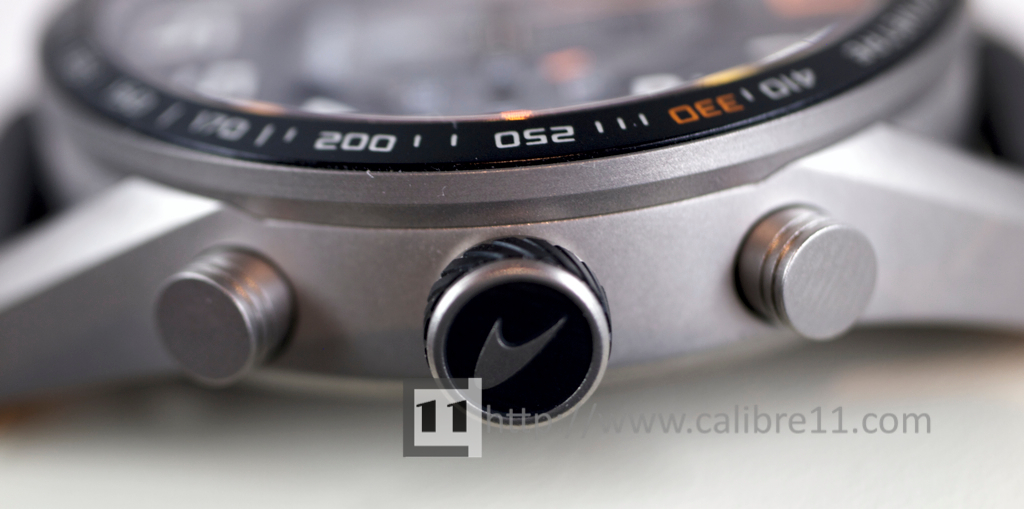 The crown features a rubber “over-moulding” and helps give the Titanium model its own look.
The crown features a rubber “over-moulding” and helps give the Titanium model its own look.
Dial
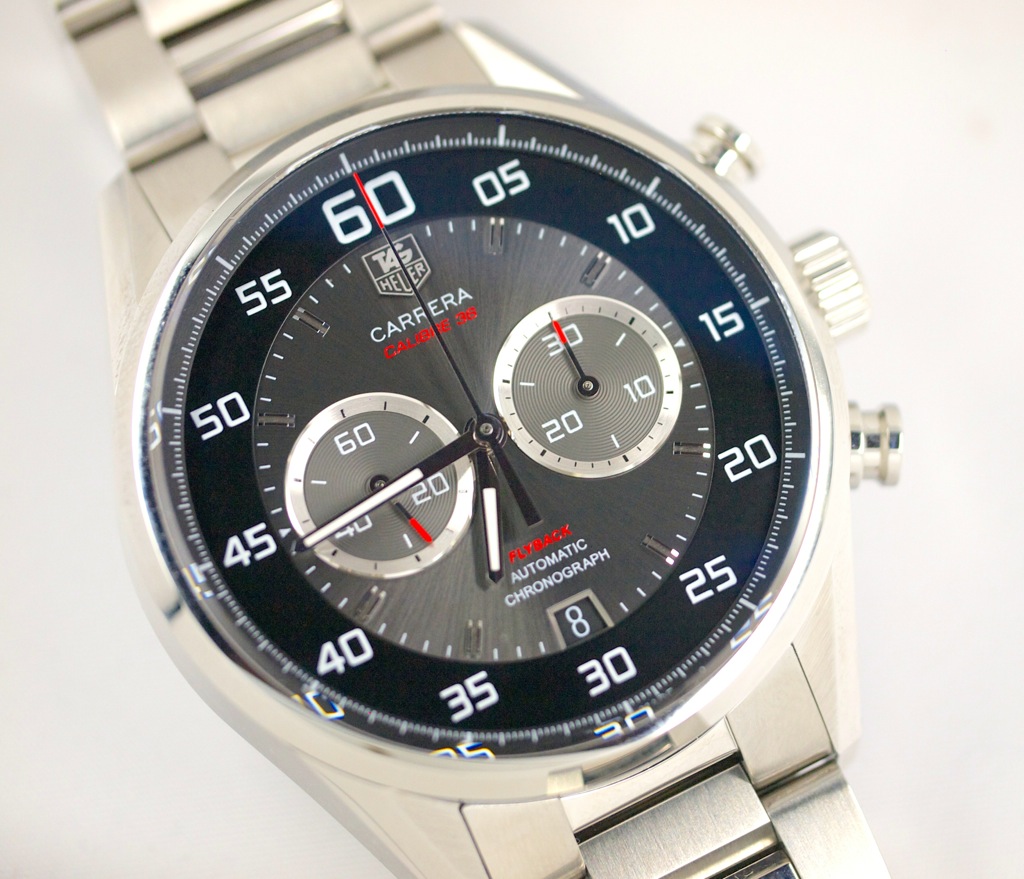 As discussed earlier, the dial has a two-element design, with the steel models offering a contrasting outer ring and centre dial- Silver (White) and Anthracite or Black and Anthracite. Note how the minute hand only extends to the edge of the centre dial rather than to edge of the dial as would be the case with a traditional watch. The Chronograph hand, however, is longer, again emphasising that this dial serves two purposes. The two registers are set inside angled surrounds and finished with an azurage pattern. The finishing on this dial is really special- you have the gloss finish of the outer ring, the beautiful star-burst finish of the inner dial and then the azurage pattern on the sub-dials. It’s a very interesting dial, and one that works extremely well.
As discussed earlier, the dial has a two-element design, with the steel models offering a contrasting outer ring and centre dial- Silver (White) and Anthracite or Black and Anthracite. Note how the minute hand only extends to the edge of the centre dial rather than to edge of the dial as would be the case with a traditional watch. The Chronograph hand, however, is longer, again emphasising that this dial serves two purposes. The two registers are set inside angled surrounds and finished with an azurage pattern. The finishing on this dial is really special- you have the gloss finish of the outer ring, the beautiful star-burst finish of the inner dial and then the azurage pattern on the sub-dials. It’s a very interesting dial, and one that works extremely well. 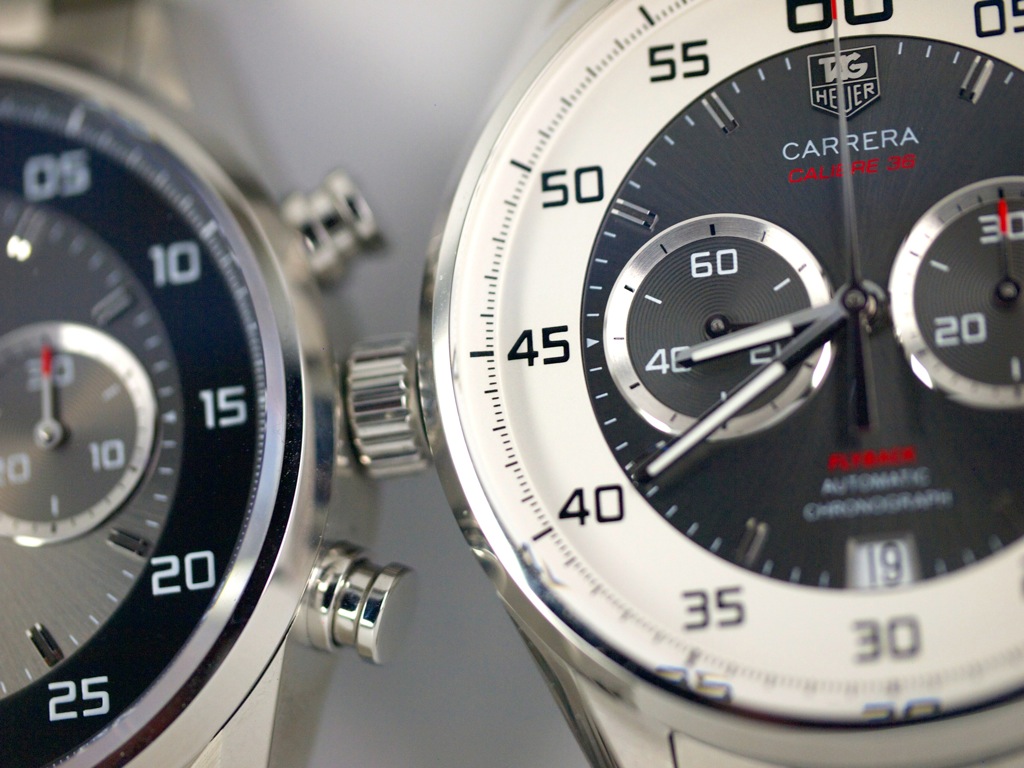 The Titanium model goes for the Full Black look and so has a Black outer ring and a Black inner-dial. This lack of contrast makes it harder to differentiate between the two elements of the dial, so TAG Heuer has slightly sunken the inner-dial on the Titanium Carrera Calibre 36 to provide a visual separation. I have to say this is a nice touch- when you think about the effort and hours that go into watch design, its small details like this that differentiate a well designed watch from the rest.
The Titanium model goes for the Full Black look and so has a Black outer ring and a Black inner-dial. This lack of contrast makes it harder to differentiate between the two elements of the dial, so TAG Heuer has slightly sunken the inner-dial on the Titanium Carrera Calibre 36 to provide a visual separation. I have to say this is a nice touch- when you think about the effort and hours that go into watch design, its small details like this that differentiate a well designed watch from the rest. 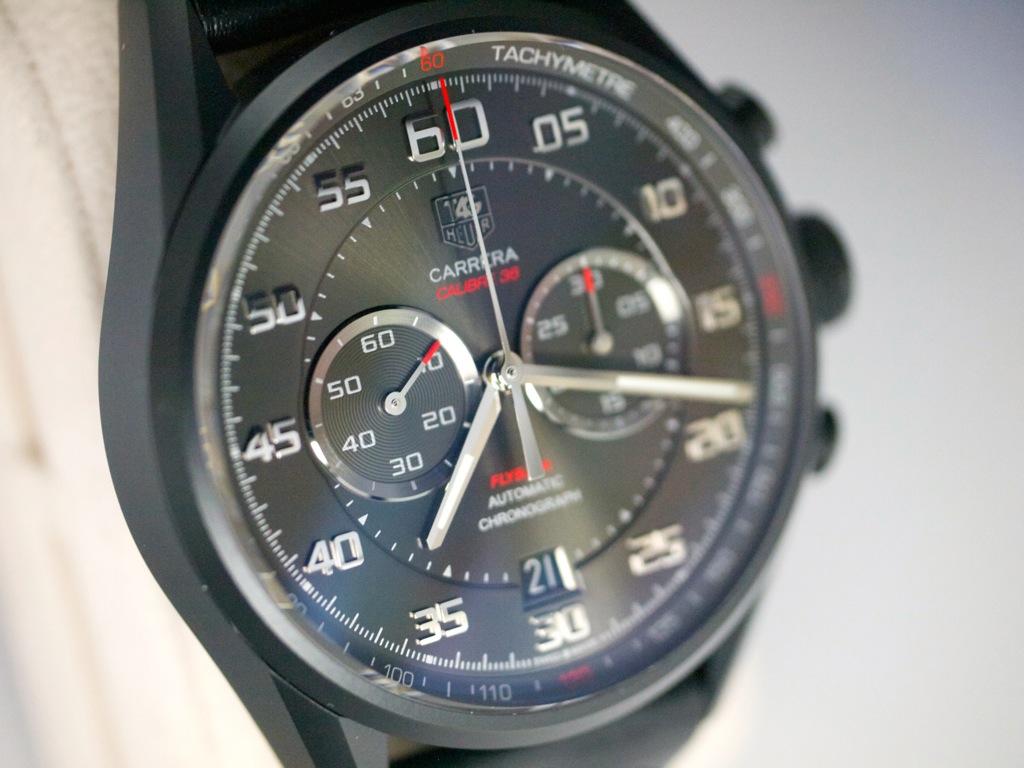 The Carrera Calibre 36 Racing has a tachy scale on the inner flange, with red numerals at the 240, 120 and 80 marks. The other point to note about the Titanium model is that the hands are longer than those on the stainless steel models. This is due to the redesigned dial, with the tachy. scale on the flange pushing the minute scale to the dial. But while we’ve talked a lot about the logical and historical rationale for the dial design, the truth is that there is also a practical one- the El Primero only has a diameter of 30mm, so when it is fitted to a 43mm case, the chronograph registers can appear too close together, giving a cross-eyed look. The two-element dial distracts the eye from this, and allows a small movement to be fitted in a larger case.
The Carrera Calibre 36 Racing has a tachy scale on the inner flange, with red numerals at the 240, 120 and 80 marks. The other point to note about the Titanium model is that the hands are longer than those on the stainless steel models. This is due to the redesigned dial, with the tachy. scale on the flange pushing the minute scale to the dial. But while we’ve talked a lot about the logical and historical rationale for the dial design, the truth is that there is also a practical one- the El Primero only has a diameter of 30mm, so when it is fitted to a 43mm case, the chronograph registers can appear too close together, giving a cross-eyed look. The two-element dial distracts the eye from this, and allows a small movement to be fitted in a larger case.
Strap & Bracelet
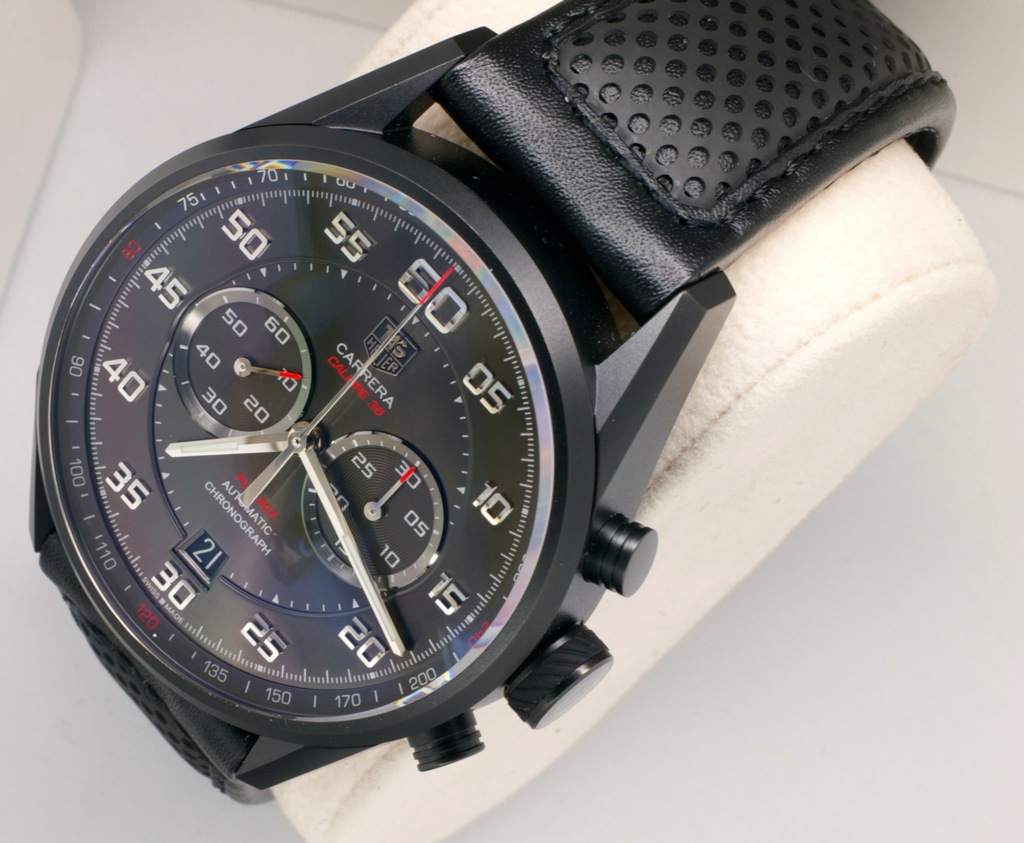 Let’s start this time with the Carrera 36 Racing, which is only available with a leather strap. Sewn over the top of the strap is a rubber finish, which gives the strap a rally-band look. It’s a beautiful strap and features a titanium deployant system.
Let’s start this time with the Carrera 36 Racing, which is only available with a leather strap. Sewn over the top of the strap is a rubber finish, which gives the strap a rally-band look. It’s a beautiful strap and features a titanium deployant system. 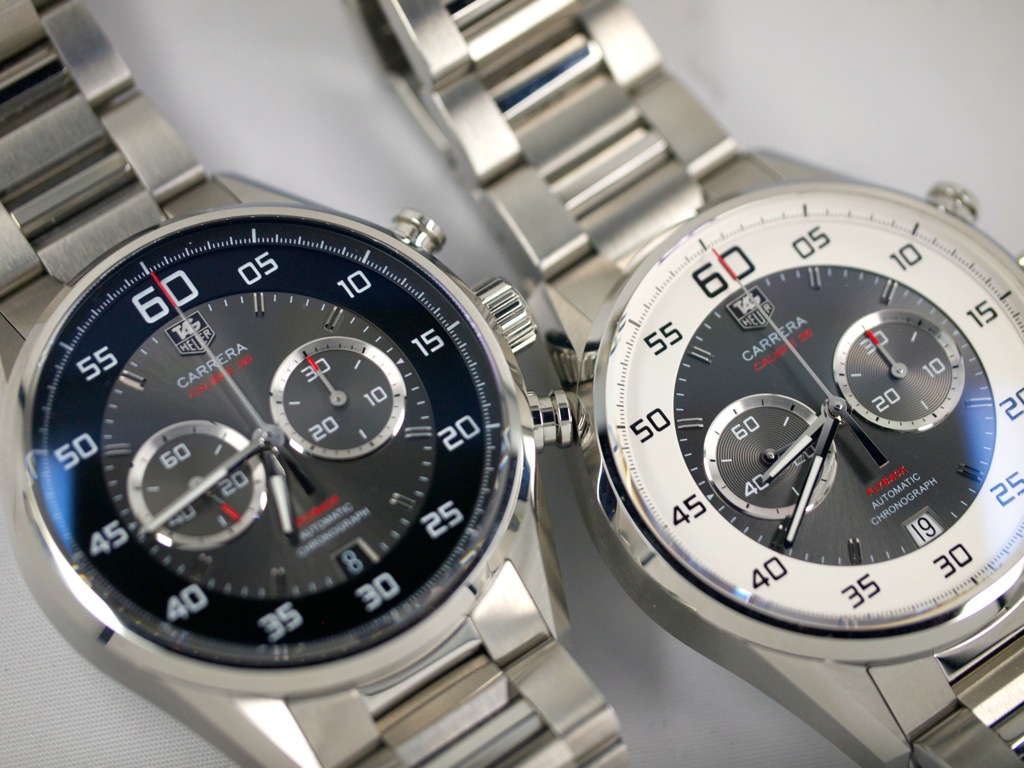 The Silver and Black dial models have two choices, either a Black alligator strap, or the H-Link bracelet from the Grand Carrera, which is now offered broadly across the TAG Heuer range.
The Silver and Black dial models have two choices, either a Black alligator strap, or the H-Link bracelet from the Grand Carrera, which is now offered broadly across the TAG Heuer range.
Movement- Calibre 36
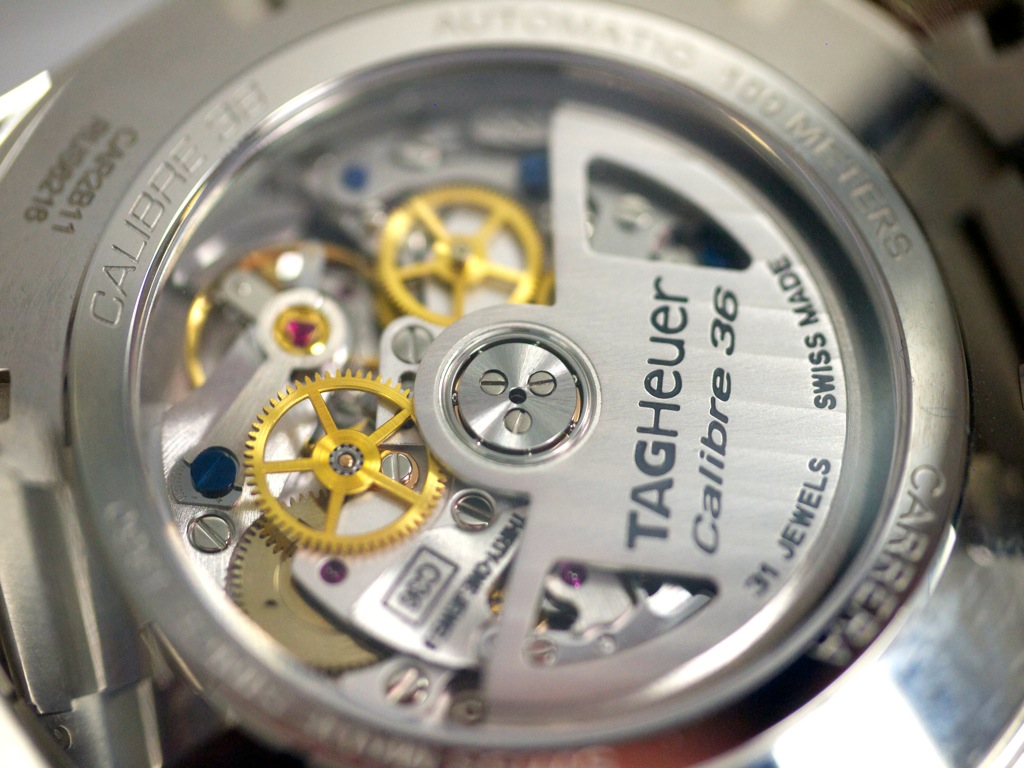 While TAG Heuer refer to the movement as a Calibre 36, even though is not exactly the same as other Calibre 36 models. While the Calibre 36 is essentially an El Primero 400, the Calibre 36 Flyback is based on the El Primero 405. Still, TAG Heuer take the same approach with the Calibre 36 in the Grand Carrera, which is a modified El Primero 400 with 42 different components, yet still wearing the Calibre 36 badge. The Calibre 36 is a beautiful looking movement, a view you can enjoy from the sapphire caseback.
While TAG Heuer refer to the movement as a Calibre 36, even though is not exactly the same as other Calibre 36 models. While the Calibre 36 is essentially an El Primero 400, the Calibre 36 Flyback is based on the El Primero 405. Still, TAG Heuer take the same approach with the Calibre 36 in the Grand Carrera, which is a modified El Primero 400 with 42 different components, yet still wearing the Calibre 36 badge. The Calibre 36 is a beautiful looking movement, a view you can enjoy from the sapphire caseback.
Carrera Calibre 36 Range
Reference CAR2B11- Silver & Anthracite
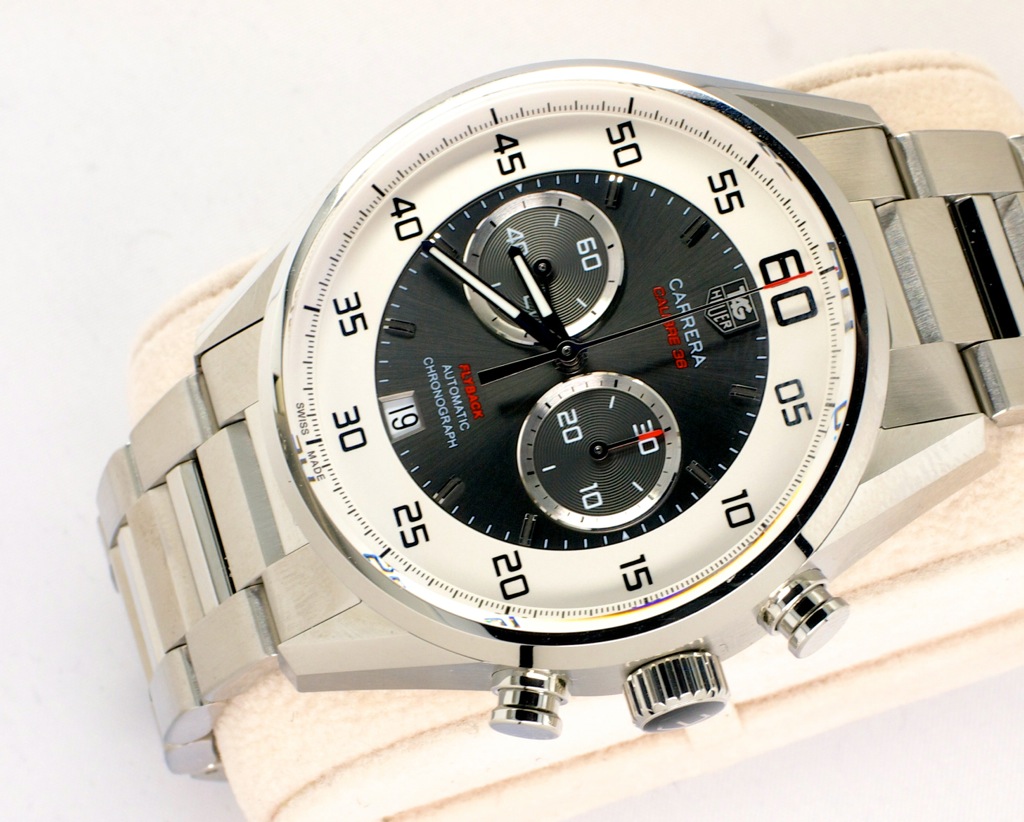
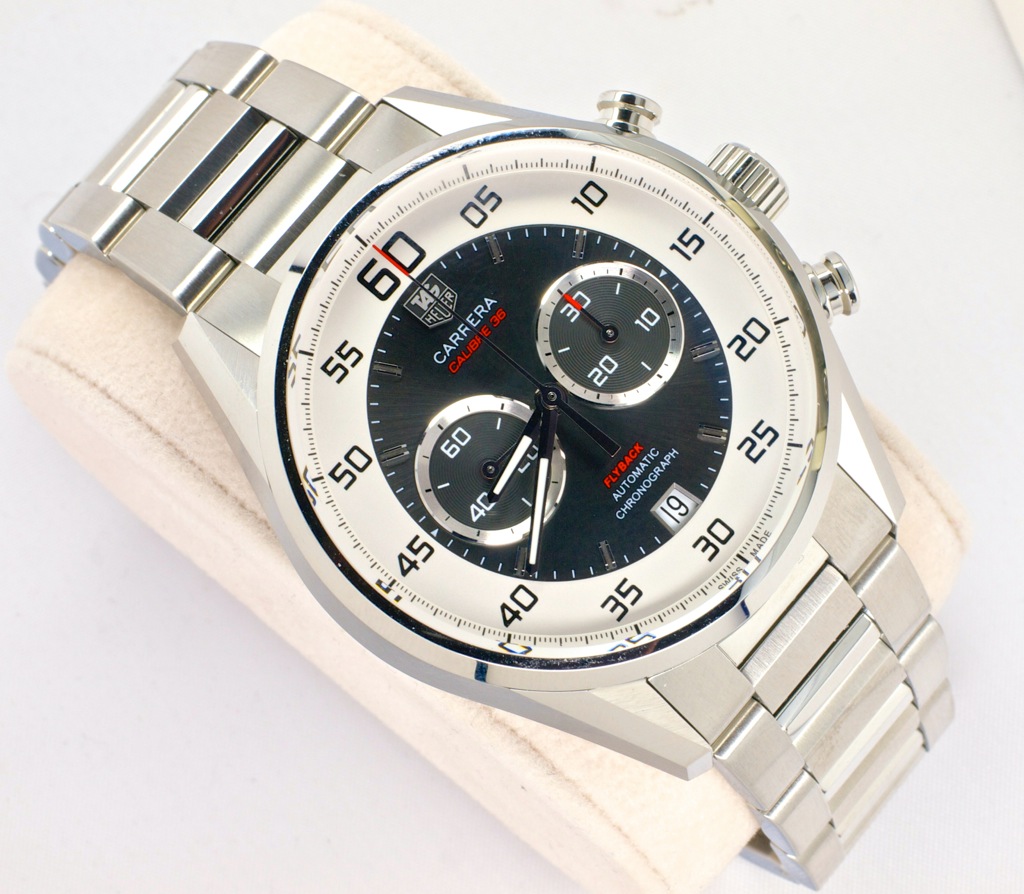
Reference CAR2B10- Black & Anthracite
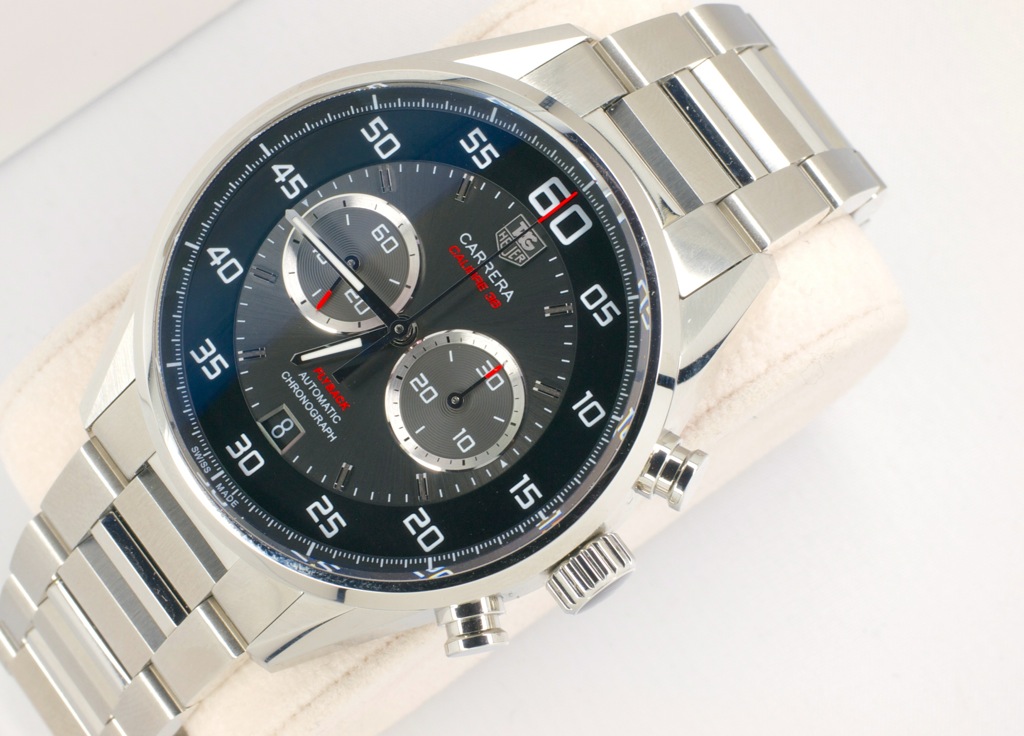
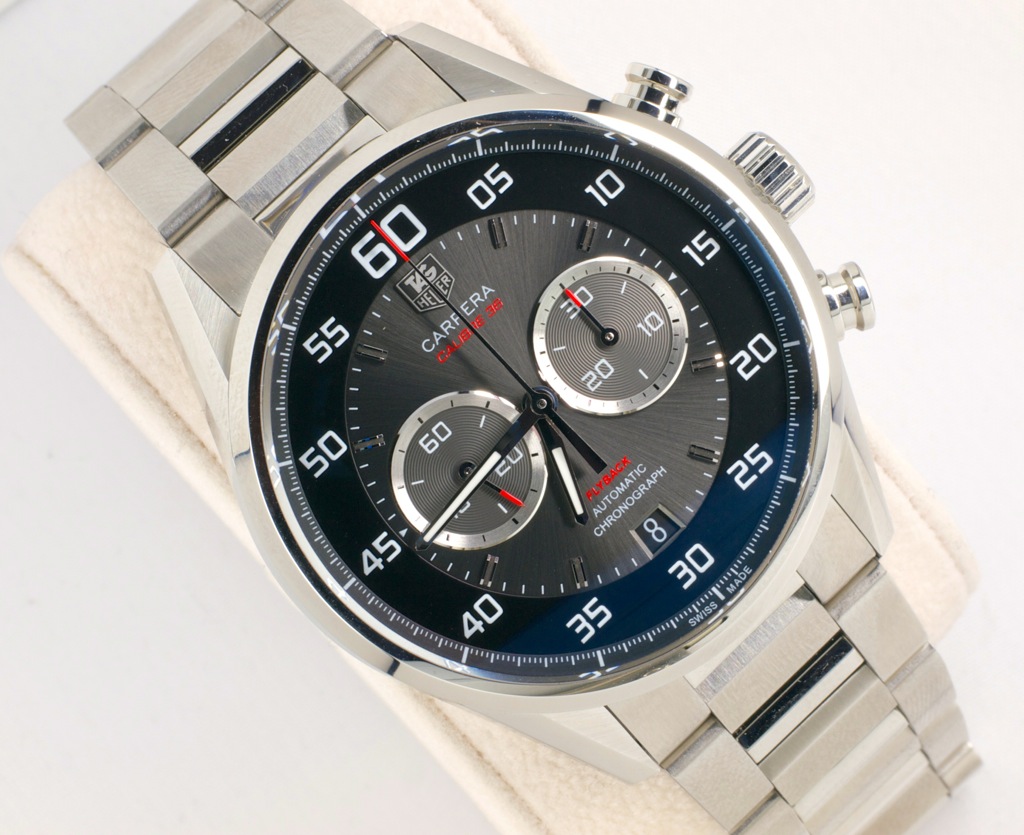
Reference CAR2B80- Carrera Racing- Black Titanium
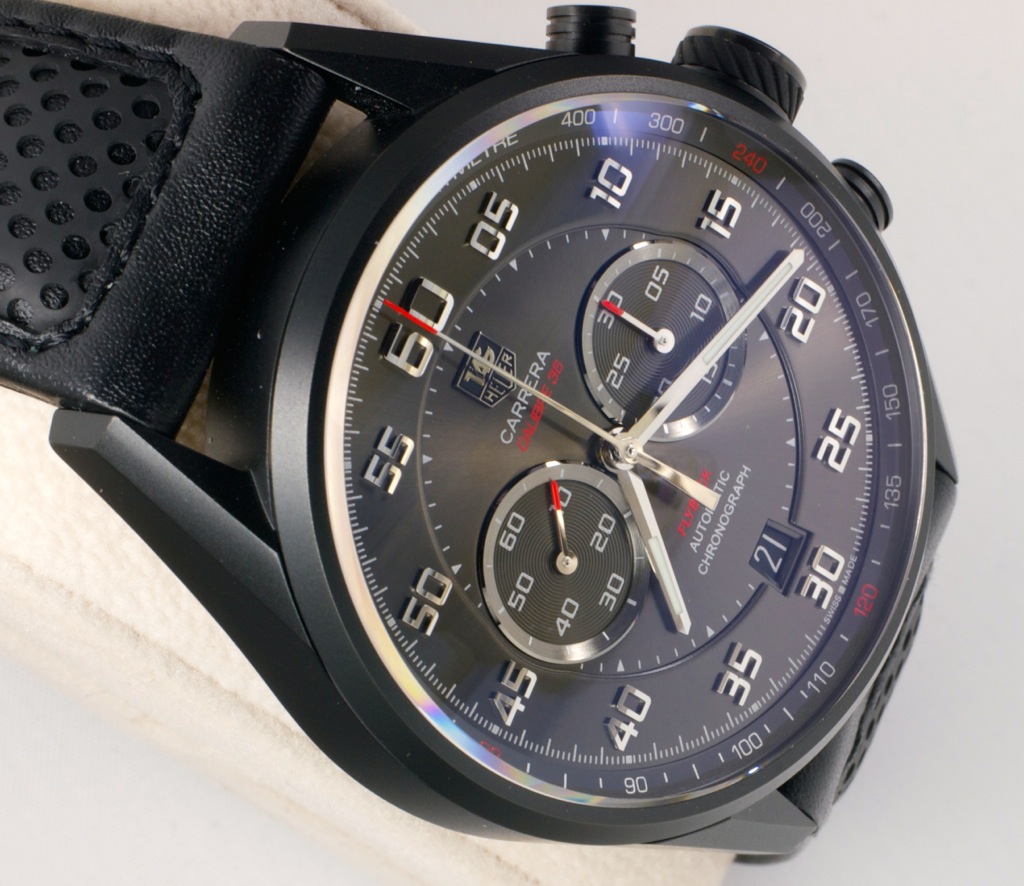
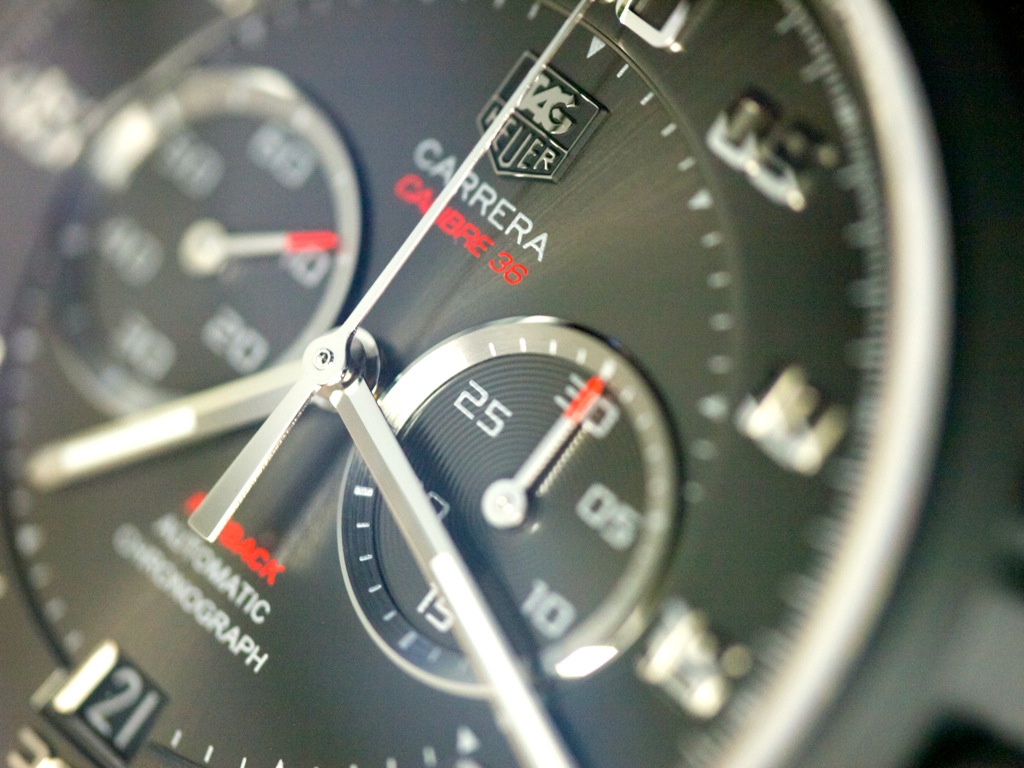
On the Wrist
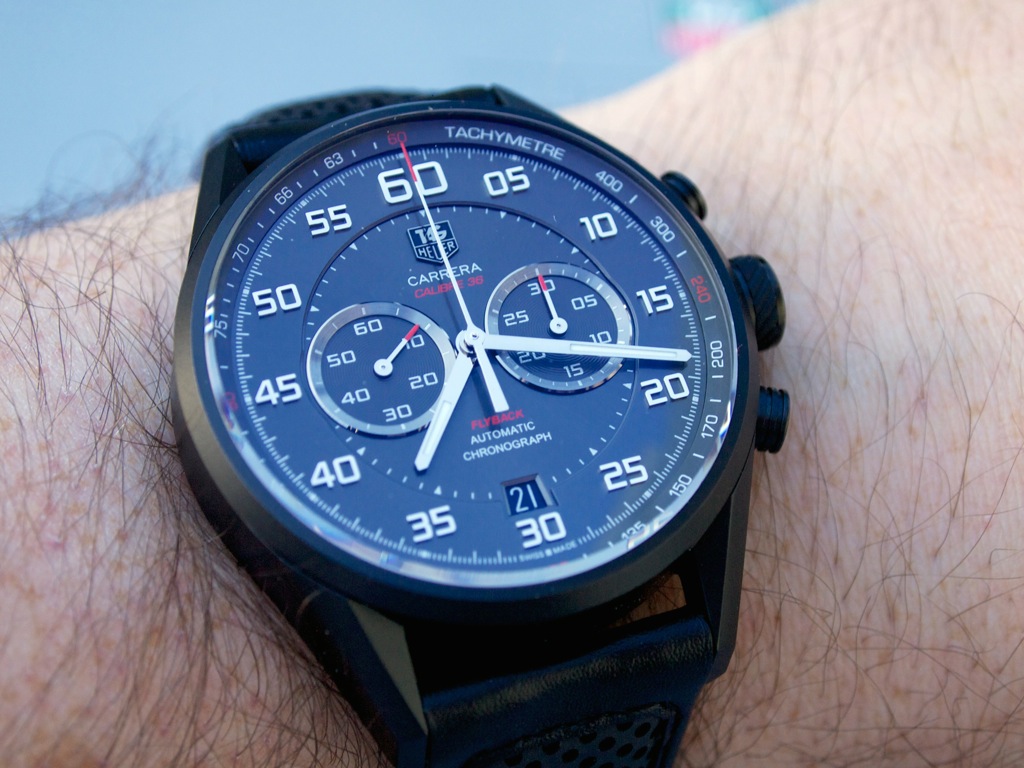 OK, enough with the details- how does the watch feel on the wrist? For a large watch, it doesn’t feel top-heavy as some can, even on the bracelet. This is probably because the case is wider and flatter than say a Carrera 1887. But bit being top-heavy doesn’t mean that it’s not a heavy watch- it is when fitted with the bracelet. Of course, buyers who want a 43mm watch generally want a substantial watch, so I don’t expect that to be an issue for most. For me, I preferred the lighter Titanium case and the leather strap.
OK, enough with the details- how does the watch feel on the wrist? For a large watch, it doesn’t feel top-heavy as some can, even on the bracelet. This is probably because the case is wider and flatter than say a Carrera 1887. But bit being top-heavy doesn’t mean that it’s not a heavy watch- it is when fitted with the bracelet. Of course, buyers who want a 43mm watch generally want a substantial watch, so I don’t expect that to be an issue for most. For me, I preferred the lighter Titanium case and the leather strap. 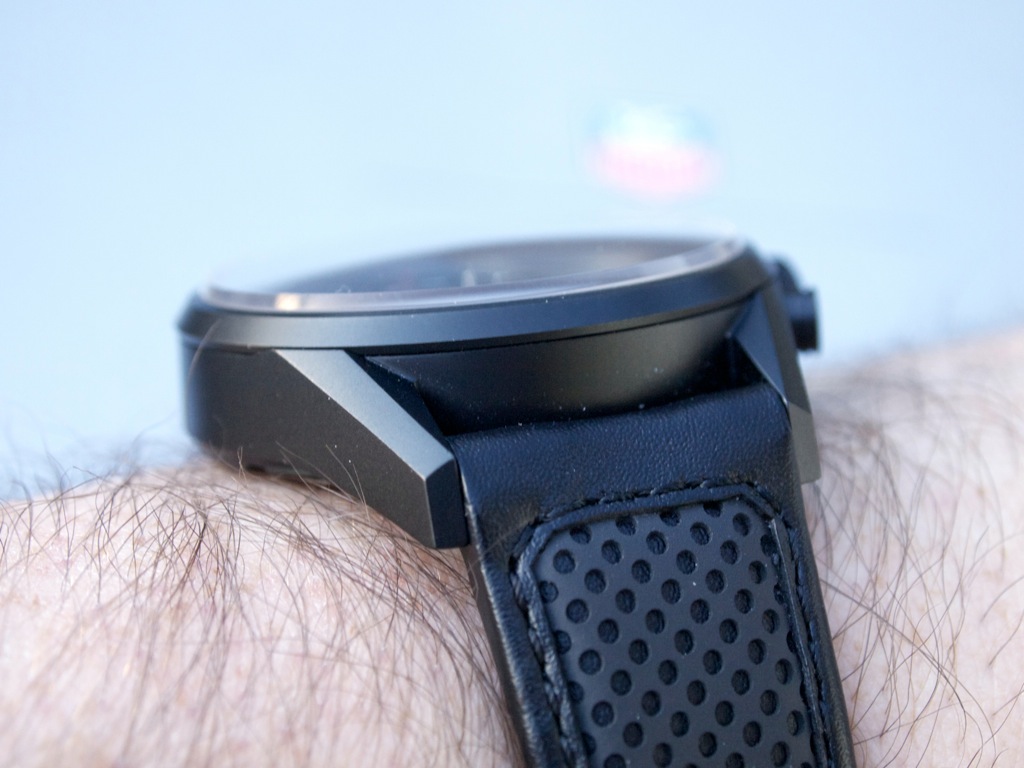 One point to note that the legibility of the Carrera Calibre 36 Racing is highly light dependent. The hands and applied numerals on the dial are “Black Gold” which (confusingly), does not mean that they are made from Gold, but rather this is the name of the solution that they are treated it to give a darkened finish.
One point to note that the legibility of the Carrera Calibre 36 Racing is highly light dependent. The hands and applied numerals on the dial are “Black Gold” which (confusingly), does not mean that they are made from Gold, but rather this is the name of the solution that they are treated it to give a darkened finish.
At a slight angle, the light hits the numerals beautifully…  ..but in certain light- and when viewed head-on- the numerals can be difficult to see.
..but in certain light- and when viewed head-on- the numerals can be difficult to see. 
In Summary
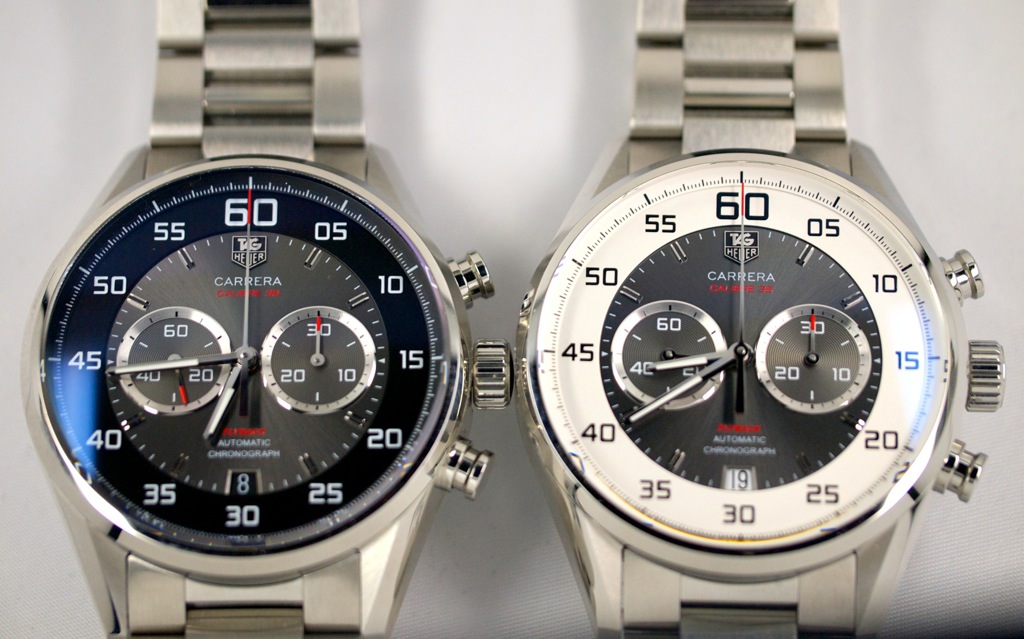 The TAG Heuer Carrera Calibre 36 Flyback quite rightly sits at the top of the [production] Carrera range, with a distinctive design, beautifully finished dial, solid case- and of course, that movement. It’s designed for those who love larger cases, so if you are more used to say a 41mm case, it’s worth trying on before you buy to make sure you are comfortable with the size. I could see myself owning either of the three models. I love the contrast of the Silver and Anthracite, while the Black and Anthracite looks particularly sharp on the Black leather strap.
The TAG Heuer Carrera Calibre 36 Flyback quite rightly sits at the top of the [production] Carrera range, with a distinctive design, beautifully finished dial, solid case- and of course, that movement. It’s designed for those who love larger cases, so if you are more used to say a 41mm case, it’s worth trying on before you buy to make sure you are comfortable with the size. I could see myself owning either of the three models. I love the contrast of the Silver and Anthracite, while the Black and Anthracite looks particularly sharp on the Black leather strap. 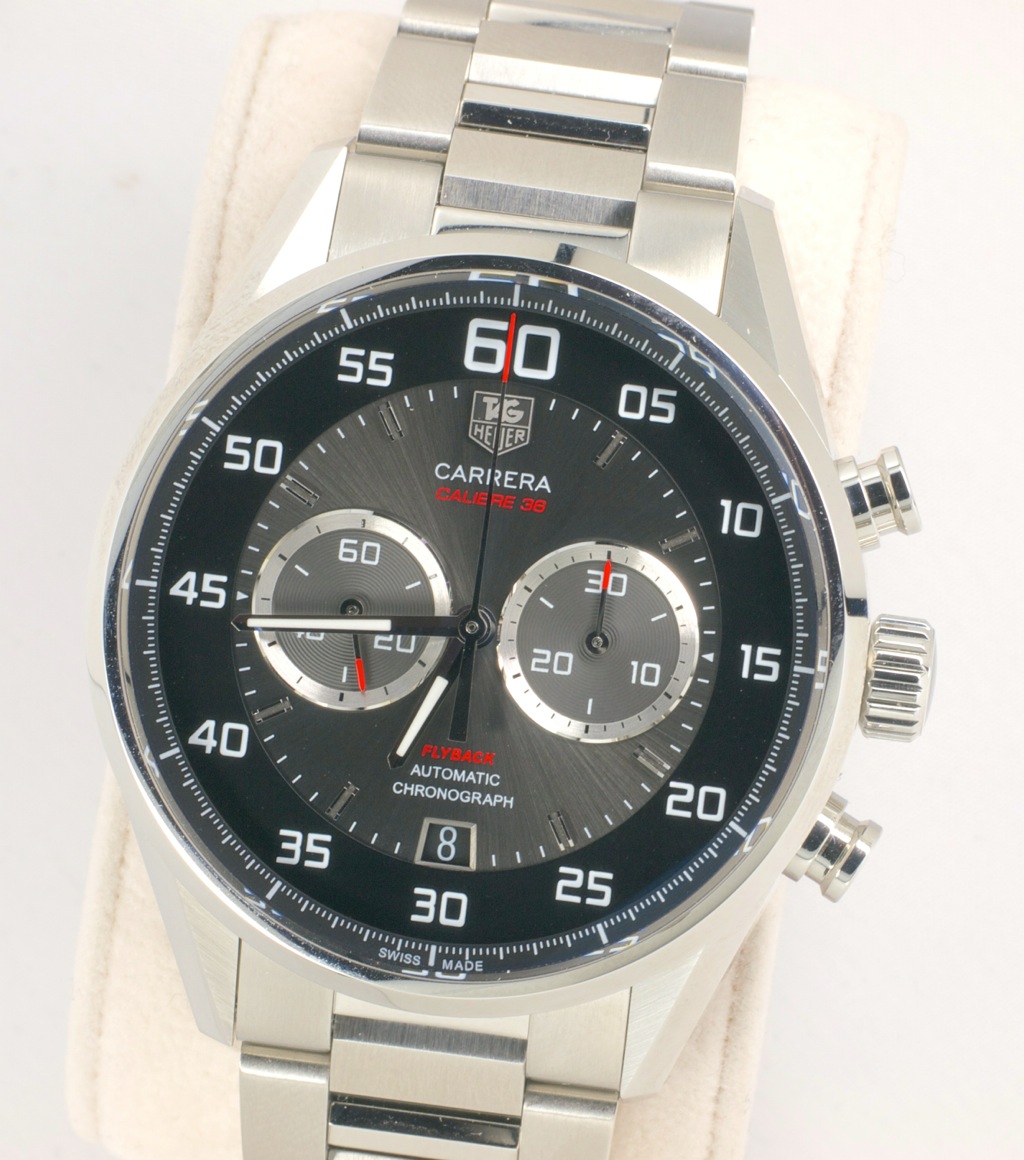 The Titanium Calibre 36 Racing is a cool design, but it does lose the prominent two element dial design and has a slightly more crowded dial. It may have taken 10 years to combine the Carrera and the El Primero, but it has been worth the wait. Hopefully, it won’t take another 10 before we see broader use of the El Primero in the Carrera range- no doubt vintage collectors would love to see a Calibre 36 Carrera in the retro-style of the Carrera CH80.
The Titanium Calibre 36 Racing is a cool design, but it does lose the prominent two element dial design and has a slightly more crowded dial. It may have taken 10 years to combine the Carrera and the El Primero, but it has been worth the wait. Hopefully, it won’t take another 10 before we see broader use of the El Primero in the Carrera range- no doubt vintage collectors would love to see a Calibre 36 Carrera in the retro-style of the Carrera CH80.
***
